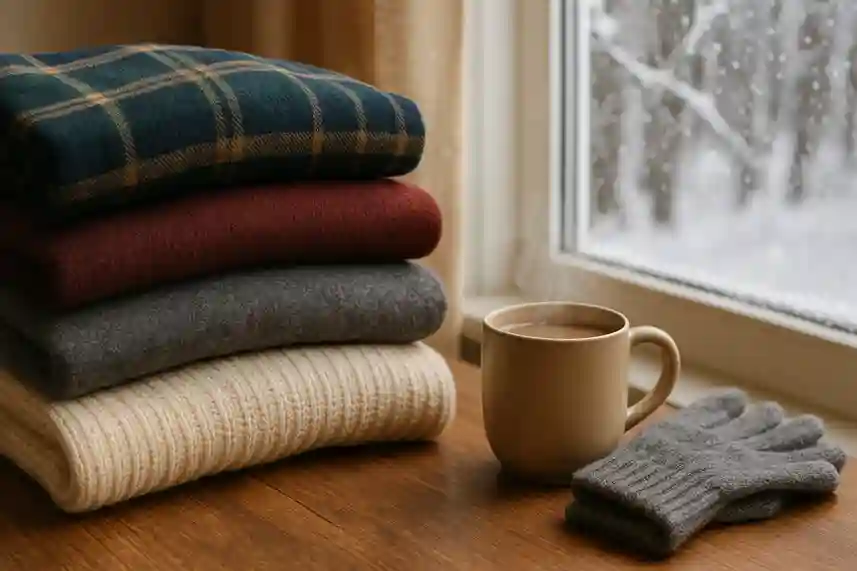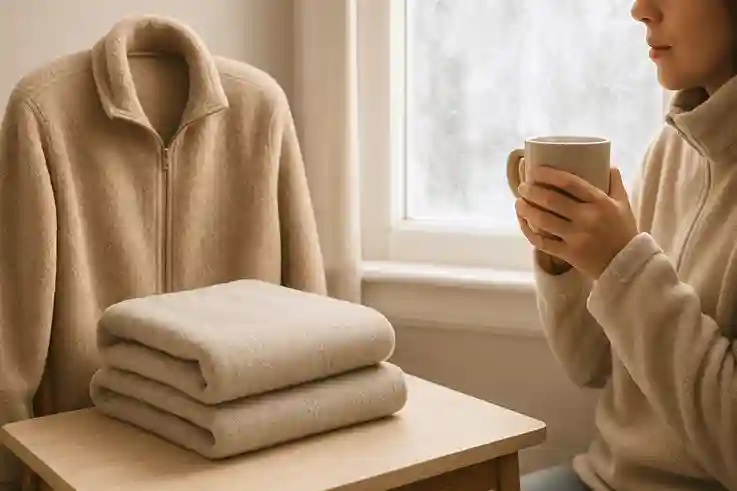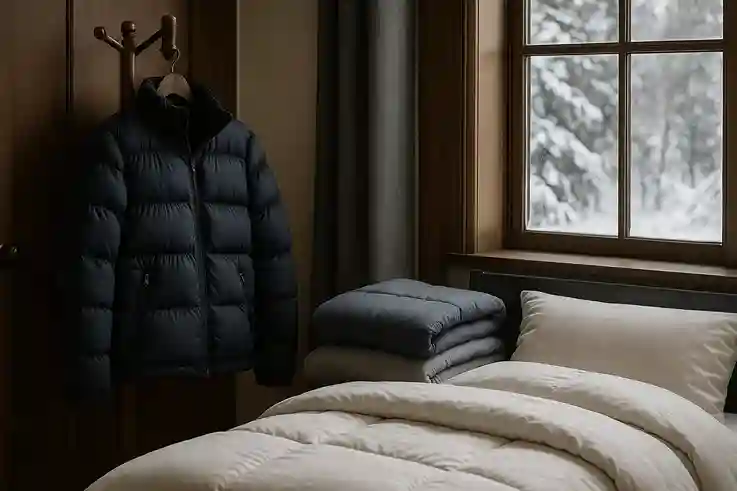Best Fabrics for Cold Weather help you stay warm, dry, and comfortable all season long. Cold temperatures can be harsh, and the fabric you wear often makes the biggest difference. The right material holds heat close to your body, yet it also allows air to move so you don’t overheat. That balance keeps you feeling comfortable indoors and outdoors.
However, warmth alone is not enough. Winter fabrics should also last through repeated wear, heavy layering, and frequent washing. Durability means your coat, sweater, or scarf will perform year after year. Breathability matters too, because trapped sweat makes you cold quickly. Finally, softness adds comfort, which is just as important as function when you wear clothing all day.
In short, fabric choice shapes how winter feels. Whether you’re walking to work or hiking in snow, the right fibers can transform your experience. That’s why learning about the best fabrics is the first step to building a warm and cozy cold-weather wardrobe.
What Makes Fabrics Best Fabrics for Cold Weather?

The best fabrics for cold weather do more than just feel warm at first touch. Insulation is the key feature because it traps heat close to your body. This barrier helps you maintain warmth even when temperatures drop quickly. At the same time, breathability matters just as much. Without it, sweat builds up and makes you feel damp. Moisture against the skin can chill you faster, so breathable fabrics keep you dry while still holding warmth.
Finally, comfort comes from softness. Fabrics that feel smooth and gentle allow long wear without irritation. A soft scarf, sweater, or lining can make cold days far more enjoyable. In short, insulation, breathability, and softness work together. When fabrics balance these three qualities, they become ideal for winter conditions.
Wool: The Timeless Classic
Heat Retention in Any Condition
Wool retains warmth even when damp. Unlike many fabrics, it holds heat instead of losing it when wet. Snow or light rain does not reduce its ability to insulate. Because of this, wool stays reliable in unpredictable winter weather. Whether you’re caught in drizzle or walking through heavy snow, it continues to protect you.
Natural Breathability
Despite its warmth, wool stays breathable. Tiny gaps between the fibers allow steady air movement. This airflow prevents sweat from collecting on your skin. As a result, moisture leaves your body instead of trapping heat in the wrong way. That balance keeps you warm without overheating, whether indoors or outdoors.
Everyday Uses
Soft types like merino feel gentle on the skin. Unlike coarse wool, they offer comfort without itch or irritation. This makes them perfect for daily wear in cold months. Wool also works well for sweaters, coats, and scarves, giving warmth in many styles. From casual outfits to formal layers, it adapts easily to different looks. Because of this versatility, it remains a timeless fabric choice for winter wardrobes.
“Effect of Wool Components in Pile Fabrics on Water Vapor Sorption, Heat Release, and Humidity Buffering” — Phillip Wayne Gibson (U.S. Army Natick Soldier Research, Development, & Engineering Center, Massachusetts, USA)
Fleece: Lightweight Warmth

Soft Yet Durable
Fleece is a synthetic fabric, but it feels soft against the skin. The fibers are designed to resist wear, so the fabric stays strong. This durability makes fleece a smart choice for repeated use. It holds shape and quality even after many washes. Because of this, fleece becomes a dependable option for both outdoor adventures and everyday winter wear.
Quick Drying Performance
One advantage of fleece is how quickly it dries. After snow, rain, or sweat, the fabric releases moisture fast. This quick action keeps your body from staying damp for long. As a result, you remain comfortable even during active winter days. It also prevents the chill that often comes from wet or heavy clothing. Because of this, fleece is trusted for both outdoor activity and daily cold-weather wear.
Perfect for Layering
Because it is lightweight, fleece layers easily with other fabrics. A fleece jacket or pullover adds warmth without creating bulk. This makes it simple to combine with coats, shells, or insulated outerwear. Athletes and hikers often choose it for this reason, since movement stays easy even with multiple layers. Whether worn under a winter coat or over a base layer, fleece performs reliably in active settings and adapts to many conditions.
Down: Maximum Insulation

Unmatched Warmth for Its Weight
Down provides an exceptional heat-to-weight ratio. Tiny clusters of soft feathers trap pockets of air, forming natural insulation. This design locks warmth close to the body without adding heaviness. Because of this, down clothing feels light yet still protective in freezing weather. It delivers comfort without bulk, making it a favorite for cold conditions.
Easy to Pack and Carry
Another strength of down is how easily it compresses. Jackets, vests, and sleeping bags fold into very small spaces. This makes them simple to pack in a backpack, suitcase, or travel bag. Once unpacked, the clusters expand and quickly regain their loft. Because of this, down becomes a practical choice for hiking, camping, or any trip where space is limited but warmth is essential.
Best in Outerwear
Down works especially well in jackets and vests. These pieces deliver maximum warmth while still allowing easy movement. The insulation adapts to body shape, so the garments feel flexible instead of stiff. Whether for daily commutes or rugged outdoor adventures, down outerwear provides reliable protection against biting cold. For many people, it remains the go-to choice when temperatures fall sharply and consistent warmth is non-negotiable.
Cotton Blends for Casual Comfort
Limits of Pure Cotton
Cotton on its own is not one of the best fabrics for cold weather. It traps moisture instead of letting it escape. When damp, cotton feels heavy and uncomfortable against the skin. This weight also speeds up heat loss, leaving you chilled. Since cotton dries slowly, the cold sensation can last for hours. Because of this, pure cotton often fails in winter conditions, making blends a far better choice.
Benefits of Blended Fabrics
Cotton blends for casual comfort solve this problem. When mixed with polyester or wool, cotton gains strength and warmth. The added fibers improve insulation and reduce moisture retention. As a result, these blends perform better in chilly conditions. That is why cotton blends often appear in lists of the best fabrics for cold weather, offering balance between softness and durability.
Everyday Winter Wear
Cotton blends are perfect for casual winter clothing. Hoodies, sweatshirts, and everyday pants often use these fabrics. They provide a balance of softness, durability, and comfort. For daily wear in mild cold, cotton blends remain a practical and cozy choice. Because they offer comfort with reliability, cotton blends also earn a place among the best fabrics for cold weather.
Cashmere: Luxury Softness

Unmatched Comfort
Cashmere is known for being extremely soft and warm. The fibers are much finer than regular wool, which gives them a silky feel. This softness makes cashmere one of the most comfortable fabrics for winter wear. Because of its unique quality, cashmere also ranks among the best fabrics for cold weather, offering both luxury and lasting comfort.
Lightweight but Insulating
Despite its delicate texture, cashmere provides strong insulation. The fine fibers trap heat effectively without adding bulk. Because of this, cashmere keeps you warm while still feeling light on the body. It works well for both indoor and outdoor use. For these reasons, cashmere is often highlighted as one of the best fabrics for cold weather.
Stylish Winter Pieces
Cashmere suits scarves, sweaters, and accessories perfectly. These pieces bring both warmth and elegance to a winter outfit. Whether you wear it for casual days or formal events, cashmere adds timeless style along with reliable comfort. That combination of beauty and function places cashmere among the best fabrics for cold weather.
Best Fabrics for Cold Weather: Synthetics
Moisture-Wicking Performance
Polyester and nylon wick moisture away from the skin. This action keeps you dry during active movement in winter conditions. By reducing sweat buildup, these fabrics help prevent chills that often follow exercise in the cold. Because they manage moisture so well, synthetics are considered some of the best fabrics for cold weather. That makes them practical choices for outdoor sports, hiking, and winter workouts.

Flexible for Active Use
Synthetics are also flexible, which supports freedom of movement. Runners, hikers, and skiers often rely on them for this reason. The stretch and light weight let you move easily without restriction. As a result, synthetics perform well in demanding outdoor conditions. Their balance of flexibility and strength makes them some of the best fabrics for cold weather when activity levels are high.
Blended for Strength
Synthetic fabrics are often blended with natural fibers. This improves performance by combining durability with softness in one garment. The added blend also enhances insulation while still keeping clothing breathable. These qualities explain why synthetics rank among the best fabrics for cold weather, especially when activity levels are high. They deliver comfort, strength, and warmth without sacrificing flexibility.
Comparison of the Best Fabrics for Cold Weather
| Fabric | Warmth Level | Breathability | Durability |
|---|---|---|---|
| Wool | Excellent insulation | Breathes very well | Long-lasting |
| Fleece | Strong warmth | Moderate airflow | Very durable |
| Down | Maximum insulation | Limited airflow | Needs care to last |
| Cotton Blends | Moderate warmth | Moderate airflow | Decent durability |
| Cashmere | Cozy and insulating | Some breathability | Needs gentle care |
| Synthetics | Balanced warmth | Very breathable | Highly durable |
Layering With the Best Fabrics for Cold Weather
The Base Layer
The base layer sits closest to your skin. Its main job is to wick moisture away and keep you dry. Fabrics like merino wool or performance synthetics work best for this layer. By moving sweat away quickly, they prevent chills from damp clothing. A dry base layer sets the foundation for warmth and comfort, making it a key part of the best fabrics for cold weather systems.
The Mid Layer
The mid layer traps heat close to your body. Fleece, wool, or down are common choices for this section of clothing. These fabrics hold warmth effectively while still allowing limited airflow. That balance prevents overheating yet keeps you insulated in freezing temperatures. Because of these qualities, mid layers often feature some of the best fabrics for cold weather, making them essential for reliable winter comfort.
The Outer Layer
The outer layer shields you from wind, snow, and rain. Materials like nylon or treated polyester resist these harsh conditions effectively. By blocking the elements, this layer protects the insulation underneath and keeps your body stable. When combined with a base and mid layer, the system creates lasting protection. Together, these layers highlight how the best fabrics for cold weather work in harmony to provide warmth, dryness, and flexibility.
Quick Tips for Choosing Winter Fabrics
Pick wool or cashmere
Pick wool or cashmere for warmth and softness in everyday wear. Both fabrics provide strong insulation while feeling gentle on the skin. Wool is versatile and durable, while cashmere offers a touch of luxury. Because of these qualities, they are often counted among the best fabrics for cold weather, especially when comfort matters as much as warmth.
Choose fleece or synthetics
Choose fleece or synthetics if you need lightweight layers for sports. Both fabrics keep weight low while still providing dependable warmth. Fleece dries quickly, making it useful for outdoor workouts in changing weather. Synthetics like polyester and nylon wick moisture away, which prevents sweat from chilling your body. These features make them some of the best fabrics for cold weather when activity and movement are your top priorities.
Maximum insulation
Go with down for maximum insulation in freezing conditions. The clusters of fine feathers trap air, creating powerful warmth without adding much weight. This makes down perfect for jackets, vests, and even sleeping bags. Because it compresses easily, it also works well for travel or outdoor adventures. For these reasons, down remains one of the best fabrics for cold weather when you need unmatched protection from extreme cold.
Use cotton blends
Use cotton blends for casual comfort in mild cold. Pure cotton holds moisture, but blending it with polyester or wool improves performance. These mixes provide better insulation while staying breathable and soft. Hoodies, sweatshirts, and casual pants often use cotton blends for this reason. While not ideal for extreme cold, they still count among the best fabrics for cold weather when your goal is everyday comfort in lighter winter conditions.
Always layer fabrics
Always layer fabrics to trap heat and block wind. A base layer keeps you dry by moving sweat away. A mid layer, often fleece or wool, locks in warmth. An outer shell made from nylon or treated polyester shields you from snow and rain. When combined, these layers create one of the best fabrics for cold weather systems, offering warmth, dryness, and flexibility in changing conditions.
No single fabric works in every situation. Instead, combine pieces wisely to build a wardrobe that adapts to changing weather. The best fabrics for cold weather make winter not just bearable but enjoyable.
“The right fabric can make winter clothing feel lighter, warmer, and far more comfortable. Choosing wisely is the difference between simply surviving the cold and actually enjoying it.” — Dr. Emily Carter, Textile Science Researcher
Frequently Asked Questions
Conclusion
The best fabrics for cold weather combine warmth, breathability, durability, and comfort. Wool, fleece, down, cotton blends, cashmere, and synthetics each bring unique strengths to a winter wardrobe. From outdoor adventures to cozy indoor wear, the right fabric makes cold days easier and far more enjoyable. Layering these fabrics adds extra protection, keeping you warm, dry, and flexible in shifting conditions.
No single fabric works perfectly in every situation. However, understanding their qualities helps you make smart choices. When you match fabric to both climate and activity, you create a wardrobe that feels reliable, soft, and protective. In the end, the best fabrics for cold weather don’t just keep you warm — they make winter living comfortable, practical, and stylish.
What about you? Which fabric do you rely on most during the cold months?
Share your thoughts, experiences, or favorite winter picks in the comments below — let’s start the conversation!

Silvia Heart is a lifestyle and wellness writer with a background in apparel and a degree in fashion. She blends creativity with practical insights, guiding readers toward intentional, balanced living. Through her approachable style and thoughtful storytelling, Silvia inspires her community to embrace both everyday joy and personal growth.


